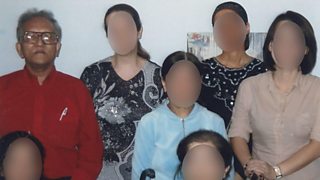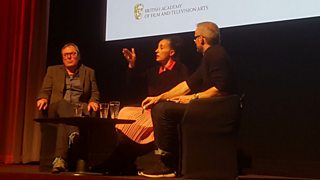Doug Block wrote his top tips on a website called IndieWire in which he says "Any advice I give for getting interview subjects to open up on camera comes with a caveat. On my own films I almost always work as a one-person crew, which inherently makes for a more casual atmosphere and greater intimacy (it also means my addled brain must juggle camera, sound, producing and interviewing duties all at once!). Nevertheless, the following tips will largely apply to most documentary interview situations. They’re not rules, just observations and lessons learned that have served me well over the years."
Doug Block is a New York-based documentary filmmaker who has won increasing international recognition as a master of the autobiographical film form. He also notes that most of the time he runs interviews as a one man band which is very similar to mine and george's situation when filming this doc. In addition to “112 Weddings,” his features include “The Kids Grow Up,” and “51 Birch Street.” He is also the founder and co-host of The D-Word, the online community and discussion forum for documentary filmmakers worldwide.
“112 Weddings” screened at festivals around the world, premiered on HBO in June 2014 and is currently available on iTunes, DVD and other digital platforms.
Doug's tips are as follows:
1. Beware of pre-interviewing.
It’s not fun to have an interview subject tell you a fascinating story or share a profound insight beforehand, leaving you to spend the actual interview trying to recapture the magic. When I first contact a subject, naturally I explain what the film is about and how they’ll fit in, but only enough to get them on board and agree to be interviewed. Even once I’m in the room with them and setting up, I talk about anything and everything else until the interview begins. The first time is invariably the freshest and best, so do your utmost to save it for when the camera is rolling.2. Relax.
For me, the goal of any interview is to make the subject feel comfortable enough to let their hair down and talk freely. To get him or her loose and relaxed, I’ll joke around, make fun of myself, tell stories — whatever I can do to make it seem like the interview is no big fucking deal. The same goes for myself – I need to be relaxed, as well. I try to focus on enjoying the conversation and learning new things rather than dwelling on how critical it might be to the film.3. Don’t anticipate the answers.
Documentaries really can’t be pre-scripted. Even if you’re in the middle of editing and think you know exactly what you need a subject to say, don’t try to force feed an answer. I do my homework and come with a long written list of questions that I keep close at hand. But, much like with actors, the preparation is all so that I can be totally in the moment when the interview starts. And then….4. Listen.
Listen closely, listen fully and go where the conversation leads you. This approach may take more work in editing but it will give you a wealth of great sound bites, I assure you. Don’t be afraid of silence, either. I often allow a subject to finish what they’re saying and simply leave things hanging. They’ll usually get uncomfortable and fill in the silence with more chatter. Even if they don’t, you’ll sometimes get an interesting expression on their face.
5. Embrace evasiveness.
When someone evades a question it’s often more revealing than anything they might say. Pauses, awkward silences, grimaces and body language comprise a major part of the cinematic vocabulary, and makes the audience work to fill in what’s left unsaid. With “112 Weddings” I had my wedding couples sit side-by-side and filmed them mainly in a two-shot. What they didn’t say was poignant, often funny and endlessly fascinating. And spoke volumes about their relationship.6. Be authentic.
Don’t try to come off as more knowledgeable or expert than you are. In fact, I sometimes like to do the exact opposite. I’ve found ignorance is often a very effective place to come from as an interviewer (and comes alarmingly easily for me). That said, it’s important that your subjects trust you, and trust that your film will be a good one. Before the interview, send them links to your previous films, or at least some of your more glowing reviews. Let them feel they’re in good hands, that you won’t make them look bad or get cheap laughs at their expense. And then protect them in the edit room. With that trust comes great responsibility, so don’t abuse your position of power.
Along with these really helpful tips from this American film maker i found some advice online from the one and only BBC! Of course i thought if they are advising on this kind of thing AND they are a british company i should definitely check them out. The article was titled "Balancing head and heart when filming sensitive subjects" and gave examples of situations BBC documentary maker Vanessa Engle actually had to handle and how she approached said subjects. I will copy the text of the article below and note which points particulaly helped me.
How would you approach an interview with a woman who had been raised in captivity for 30 years and brainwashed into believing that if she disobeyed her controlling father, major global disasters would strike?
Or an interview with someone who believes that, as a journalist, you are a mouthpiece of the fascist state and that an attempt was made on their life as they came to meet you?
Tricky, to say the least. This is exactly what BBC documentary-maker Vanessa Engle had to resolve for BBC Two’s revealing investigation The Cult Next Door.
“Nothing prepared me for how strange and unfathomable this story is. It’s very disturbing”, Engle told an audience at a BAFTA preview screening in London.
Initial meetings with key interviewees had been extremely difficult to secure. The first was with Katy, born into the Maoist cult led by her father Aravindan Balakrishnan in a small house in Herne Hill, south London. For three decades, until her rescue, she had little contact with the outside world.
Understandably, she was at first very reluctant to talk and kept cancelling over several months, despite long phone calls with the producer. When she did eventually choose to get in contact with Engle, the groundwork could begin.

Aravindan Balakrishnan and some of the cult members. He was later jailed for 23 years
Speaking to me after the BAFTA event, the film-maker described the “rigorous preparation” that was needed for each of the interviews she conducted. These were women who had been held captive by the cult leader and subjected to brutal physical and mental abuse.
She researched 40 years of press coverage documenting 75-year-old Balakrishnan’s Maoist movement, filling three lever-arch files of information for each person, to isolate exactly what to ask them.
“It was an eight-month process. I was fanatical about it,” she said.
To give the women a chance to come forward and open up to her, Engle felt she had to “create a safe environment” that would put them at ease: “You have to be aware that you are dealing with vulnerable people.”
The make-up of the crew was a part of that process. They had to be people who exuded “experienced, professional calm”. And if contributors like these are to feel comfortable, it is often best to avoid delays at the start so the interviewee’s nerves aren’t given opportunity to build, she advised.
Being emotionally intelligent was one of the most important considerations on this assignment, Engle stressed, and one of the most personally challenging, even for a film-maker of her experience. Past documentary credits include the harrowing Love You To Death: A Year of Domestic Violence and her examination of the cosmetic surgery business, Inside Harley Street.
There were aspects of the former captives’ delusions that they had not yet come to terms with, she explained, and which needed to be played along with to elicit responses: “I don’t have any training dealing with people who are delusional. You have to play along, but I had a moral conflict within myself.”
Although you have to hold it together and not let distressing subject matter affect you to the detriment of your interview, it is OK to show your human side, Engle maintains, and express genuine emotions to your interviewee.
“Think clearly at all times. You’ve got to be aware that it’s all on camera. But I’m not afraid of having feelings. I might cry and that’s fine.”

Vanessa Engle takes questions after the screening of her documentary at BAFTA
Another challenge in dealing with distressing reality is that it can be difficult to switch off afterwards. Engle admitted coming away from some of the interviews feeling depressed and even started suffering “night terrors”. She found herself worrying about her own son who was travelling in Asia at the time, and fearing for his safety.
“You become a barometer for your contributor’s unexpressed feelings. But you just have to deal with it,” she said. “You keep reminding yourself that you’re lucky it’s not happening in your daily life, and that helps.”
Engle explained how she had assured her executive producer Peter Dale that she would only make this documentary if she knew it would not cause the contributors more distress. That emotional awareness extended to the cutting room, she told me - making the correct decisions to omit material that might undermine the interviewees.
One of the cult members, Josephine, chose not to appear in the programme but her part in the story comes through in the interviews of others. After gaining her freedom, she continued to subscribe to Balakrishnan’s doctrine that journalists are tools of a British fascist state.
Consequently, her opinion differed to that of the other women interviewed, so it was important for Engle to consider Josephine’s right to reply when making the programme.
As she reminded me: “We had a duty of care towards her, even though she wasn’t in the film”.
With editorial sensitivities like these there will always be an element of emotional unpredictability that needs to be handled in a professional, intuitive manner. It is clear from speaking to Engle, however, that thorough preparation is just as key to controlling and directing such demanding interviews.

No comments:
Post a Comment